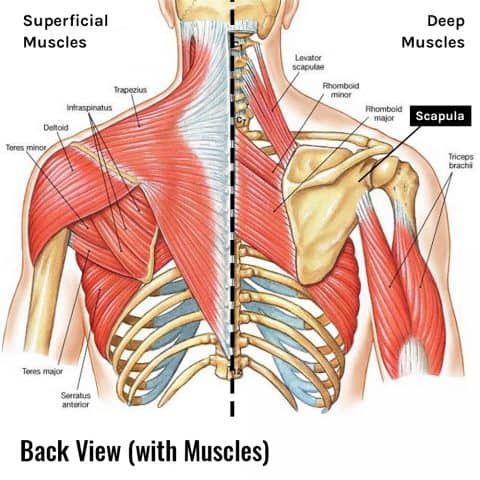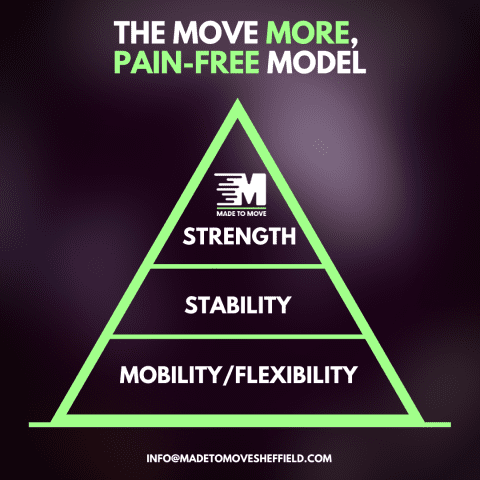Introduction
Tight shoulders can cause pain or stiffness in your neck, back, and upper body, and limit your ability to take part in daily activities or exercise. However, is shoulder tightness the actual problem here?
Your shoulders may feel tight and stiff as a result of stress, tension, and overuse. Tight shoulders can be also caused by sitting for extended periods, incorrect sleeping positions, and injuries. Extended periods of movement with a “poor posture and improper alignment” as commonly referred to are traditionally thought to be the problem. But is it?

It’s more than just your shoulder
Your shoulder is not just a joint or muscle on its own, it’s part of the neck, the ribs, and the scapula (the shoulder blade). The shoulder complex includes the humerus (upper arm), the clavicle (collar bone), and the thoracic region of your spine (the rib cage, and the scapula).
I often refer to clients as the scapula as a free-floating joint. This means it does not attach to the body apart from the humerus. However, to provide movement, the large amount of muscles that attach the scapula and humerus to the body are like levers. Simply put, they work together from different angles to provide a huge amount of movement.
The downside: The whole area depends on ligaments and muscles for stability. When those muscles get overworked (or underworked), we’re left with limited motion and instability. Which over time leads to tightness, stiffness and eventually pain (which can occur during rest or when moving).
The best approach to recovery is to move frequently — forward, backward, and to the sides — throughout the day. But if your routine tends to leave you feeling stiff by 4:00 p.m., you may need to explore more movement.
What is scapula instability?
Weakness in any one of the muscles attaching to the scapula, especially in the larger muscles such as the: serratus anterior, latissimus dorsi, rhomboids, and trapezius muscles, can alter the way the scapula moves and how the shoulder joint functions.
The shoulder needs both mobility and stability to support and stabilize the rest of the arm. Poor movement patterns and/or deficits in muscle strength at the scapula can lead to poor movement, instability and pain in the neck, upper back and arms.
Think of the scapulae as the foundation of your house. Your house is only as sturdy as its foundation. You wouldn’t build a house on sand, right? Similar to a house, upper body strength and movement rely heavily on the stability provided by the scapular muscles.
Whether you take part in sport, bench press three times a week or sit at the desk 9-5, the muscles that support the scapula require strength and mobility to prevent injury and maximise performance. Weakness in the shoulder and surrounding structures can lead to overuse of the smaller muscles in our extremities, trapped nerves, bicep tendon injuries and adapted movement patterns.

What causes tight and unstable shoulders?
Tight shoulders can be caused by several factors. You may create tension in your shoulders from everyday activities such as texting, sitting for extended periods, or carrying heavy bags.
However, often understanding the shoulder can be complicated and full of jargon. We need to take it back to basics and start assessing what is missing and what needs to be developed.
Is posture a problem?
Posture is a hot topic when it comes to addressing shoulder injuries both in and out of the sport. However, is it the problem? Or is it something more than passing the blame?
Obviously, a hunched rounded posture all day, every day is not going to do wonders to shoulder health (especially if you spend a lot of your day sitting at a computer). But other things can contribute to tight or even painful shoulders, too.
Tight and painful shoulders are typically caused by posture habits, muscle imbalances and focusing too much on certain exercises, such as too much focus on chest strength while neglecting rotator cuff and back exercises.
Unfortunately, changes in posture also can change the way we move and use our body none as movement patterns. Our posture can impact:
- Positioning of the shoulder blade
- How efficient are the muscles of the shoulder are
- How well the muscles work together
- Space available at the shoulder for movement
- Positioning of the arm as it raises
How to improve posture
Basic posture changes to improve shoulder ranges of motion include rolling shoulders back, then letting them relax down, tucking chin down lightly, and sitting up from the hips. Keep your shoulder blades down and back to “pinch” the shoulders together lightly and open up the chest.
Changing to this posture frequently and having greater awareness of positioning is vital to changing your habits. You may find setting an alarm or taking regular water breaks helpful to remind you. If you’re having difficulties with proper posture, you may want to consider getting professional help to gain motion, strength and knowledge to change your habits.
The Move More, Pain-Free Model
Keeping things simple I like to refer back to the Move More, Pain-Free model we use at Made to Move. Optimal movement occurs from correct muscular activation that allows the body segments to move through their range of motion. Poor range of motion often caused by either sedentary lifestyles or failure to address strength, flexibility and mobility can lead to elevated injury risk. If not now, down the line it will.

Therefore, addressing flexibility and mobility will allow you to move through a wider range of motion within your shoulder. Couple this with stability exercises and strengthening underactive muscles will allow you to recruit more muscle fibres, increase muscle length and ultimately increase the likelihood of stability and strength.
However, failure to address stability in these outer ranges can lead to further joint instability, tendon/ligament stress and worse dislocations as the muscles are not educated to provide stability outside their normal range of motion.
Therefore, adequate analysis and a suitable and well-justified programme should be implemented specifically to your needs, whether you are coming back from injury or looking to develop your current performance in the gym or your chosen sport.
How to treat scapula instability
How long it takes for symptoms to relieve can vary from person to person. With this, following the model previously discussed both mobility and stability need to be explored.
The traditional physiotherapy style of rehabilitation with bands is not the answer here. Often, the serratus anterior is underactive (this muscles pin draws the scapula down and closer to the rib cage) if, this is underactive there is commonly scapula winging (the scapula lifts off and anteriorly tilts.
Furthermore, the lower trapezius and rhomboids and Latisimuss Dorsi (lats) tend to be underdeveloped which places further stress on the other muscle groups such as the pecs and trapezius muscles.
If you or you know someone with this type of injury, take a look and include these in your rehabilitation:
Strengthening Exercise
Prone Ball Catch
Dumbbell Serratus Uppercut
Stretching
Trap Stretch
Tri-Chest Stretch
Other ways to treat scapular instability.
It’s important to take care of your shoulders even if they aren’t right now. Exercising regularly is key to prevention. Here are some other ways you can improve your scapula instability:
- Stay active and engage in activities that require you to use your shoulders, such as swimming or yoga.
- Go for regular massages if it’s possible, or take a few minutes each day to do self-massage and stretches that are the opposite t what you are doing.
- Avoid a sedentary lifestyle and stay as active as possible.
- Try to maintain good posture and proper alignment in your body. Pay attention to your body as you go about your daily tasks. If you sit for long periods, change your position often and get up for a short break every 30 minutes.
Take-Home Message
If you notice tension or tightness in your shoulders, it’s important to take steps to relieve the tension as soon as possible. Early treatment can reduce your risk for complications.
It’s a good idea to do exercises to loosen up your shoulders even if you don’t have severe tightness. Try to bring your awareness to this area of your body throughout the day, and work on relaxing and releasing tension. If you’re experiencing long-lasting or intense pain, seek assistance from your local sports therapist.
If your symptoms are severe or don’t go away, seek medical attention. If you are struggling to progress with this injury, we have space for you within our online coaching platform in which one of our therapists will take you through an injury assessment and consultation to understand the problematic issues and work with you to build a programme that works around your lifestyle to ensure you get back to moving more, pain-free.
Simply head to the booking calendar HERE to book your consultation now.
Don’t forget to head to our social media platforms to keep up to date with weekly free rehabilitation techniques and exercises to allow you to get back to training pain-free.

